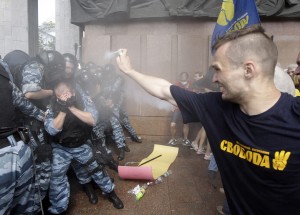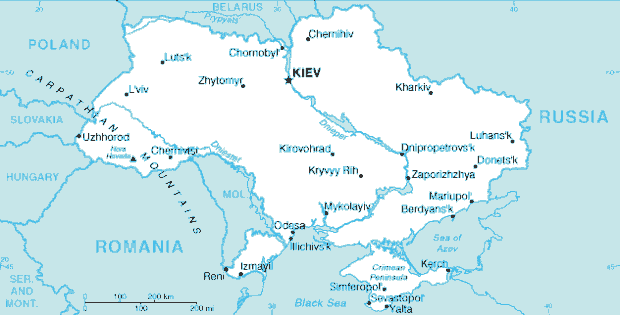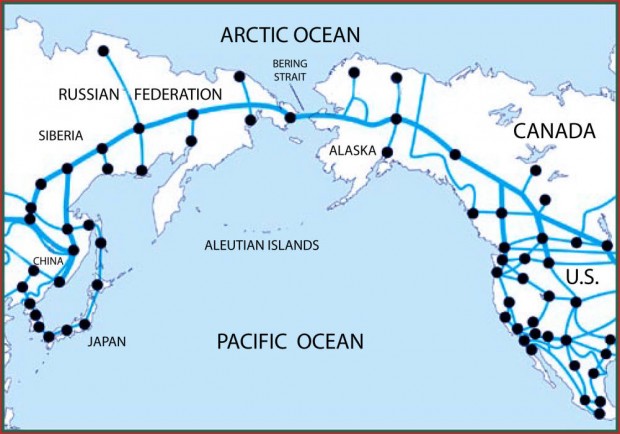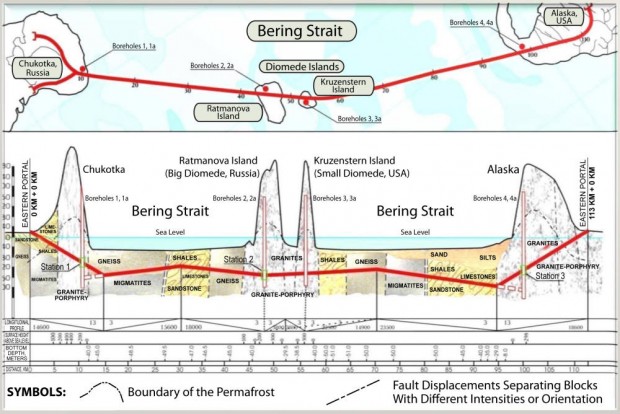
Taking language politics to heart, a member Svoboda, a Ukrainian nationalist political party strong in Western Ukraine, sprays riot police with tear gas in Kyiv, Ukraine on July 4. Nationalists fought with police over a bill that would allow the use of Russian and other minority languages in official settings. Photo: AP/Efrem Lukatsky
LVIV — It’s a sunny summer evening here in Lviv, the café and cobblestones capital of Western Ukraine.
But a steady stream of young couples are ducking down a secret archway.
They rap once at a solid wooden door, then stand back.
The door opens half way to reveal a man in forest green uniform, an automatic weapon slung over his shoulder.
He shouts: “Slava Ukraini!”
Visitors call out the password in Ukrainian: “Heroyam Slava!” – Hail to Our Heroes!
And with that, they descend into the red brick vaulted cellars of Kryjivka – an underground restaurant in the theme of the Ukrainian Insurgent Army. This partisan group fought the Soviet Red Army for almost a decade, starting in 1944.
In that war, long hidden behind the Iron Curtain’s veil of secrecy, 35,000 Soviet officials and soldiers were killed — more than twice the number of Soviet troops killed in Afghanistan during the 1980s. In reprisal, about 600,000 Western Ukrainians were “repressed” – one third executed, one third imprisoned and one third deported to distant parts of the Soviet Union.
At Kryjivka, the cellar walls are festooned with ghosts from that guerrilla campaign long lost to history – handsome, sandy haired young men posing in the forest with vaguely familiar uniforms; copies of Ukrainian language posters and pamphlets from underground presses; and Russian language diagrams of forest encampments, probably from Soviet counter-insurgency manuals.

At the underground shooting range in Lviv’s Kryjivka restaurant, VOA video journalist Austin Malloy nailed Lavrentiy Beria, Stalin’s secret police chief who directed the Soviet Union’s post WWII counterinsurgency campaign in Western Ukraine. VOA Photo: James Brooke
At the entrance, my American-accented “Heroyam Slava” prompted the armed doorman to give me a shot – of local vodka. Maybe thanks for the assistance — too little, too late — that Washington sent to the Ukrainian guerrillas in the early 1950s?
But at a table down below, I soon commit a linguistic faux pas. I ask for a beer in Russian. A Ukrainian dining companion at my table almost whacks my hand. She chides me: “No Russian spoken here!”
The gap between Russia and Western Ukraine is more than linguistic. Russia television regularly airs old Soviet movies showing Ukrainian guerrillas as fascist puppets of the Nazis, fanatics who fought on long after the war, ambushing heroic Red Army units.
At Kryjivka, where it was hard to find an empty table on Monday night, there were two traits common to the 100 or so patrons packed underground. Whether it was the young man proudly posing for souvenir photos with a (decommissioned) automatic weapon, or the two young women waiting for their turn to shoot an air rifle at a paper target of Stalin’s secret police chief, they were all in their 20s and 30s, and they were all speaking in Ukrainian.
Above ground, the linguistic landscape is the same. Over the last two centuries, the name of this city has shifted according to tides of history: from Lemberg (German) to Lwow (Polish) to Lvov (Russian) and now Lviv (Ukrainian).

Russia’s influence fades as you move from east to west in Ukraine. For centuries, the western quarter was ruled by either Poland or Austria. This western orientation was cut short by Stalin’s annexation into the Soviet Union in 1939.
Before World War II, this was a Polish-speaking city. Later, as a western colony of the Soviet Union, it was heavily Russian-speaking. But the influence of Moscow faded with independence two decades ago. Lviv is now an overwhelmingly Ukrainian speaking city. On a national level, many linguists believe that Ukrainian language use is steadily spreading east.
Here, as in Central Asia, Georgia, the Baltics and in Eastern Europe, the collapse of the Soviet empire has meant a steadily shrinking footprint for spoken Russian. In Ukraine, where Ukrainian and Russian are linguistically so close, this subtle atrophying of Russian language skills has been overshadowed by fights over language policy in Kyiv, the nation’s capital. Once a Russian speaking city, Kyiv is now increasingly bilingual.
Outside Lviv’s World War II memorial, I stopped Andrei, a 23-year-old cook who was bicycling to work. Aiming to please, he strained hard to understand my questions in Russian. He then replied in Ukrainian. It was not a political statement. Here was a young Ukrainian who could not speak Russian.
Inside the memorial, Austin Malloy, VOA’s Moscow-based video journalist, asked a gardener – in Russian – if he could shut off his lawnmower in order to film. Standing 10 paces from a Red Army statue, the gardener barked back: “What’s your nationality?”
When he learned the request was not coming from a Russian, he shut off his lawnmower, and wanted to chat, at length.
Across town, at another World War II memorial, I stopped Sergiy, a 70-year-old retired engineer. A veteran of the Soviet Army, he spoke Russian well. He said he had used it every day at the factory where he worked. As we stood under a massive Soviet-era statue of a Red Army soldier holding a sword, I asked him when was the last time he spoke Russian.
He mulled. He answered: “It must have been one year ago.”

Linguistic Field Research: Marina, an architecture student from Odessa, Ukraine’s port on the Black Sea, tells James Brooke she feels uncomfortable speaking Russian in Lviv. Although she studied Ukrainian in school, she uses it rarely in Russian-speaking Odessa. VOA Photo: Austin Malloy
On a park bench, near a 17th century chapel, I talked with Marina, an architecture student from Odessa, Ukraine’s Russian-speaking seaport on the Black Sea. Embarrassed about making grammatical mistakes, she was using Russian in Lviv. She said that put her on the defensive here.
Part of that is geography. Eastern Ukraine has a 1,576 kilometer border with Russia. Central Ukraine has a 891 kilometer border with Russian-speaking Belarus. And Western Ukraine has a total of 2,200 kilometers of borders with Hungary, Moldova, Poland, Romania, and Slovakia.
With the Polish border a one-hour drive from here, Lviv, Western Ukraine’s largest city, is closer to Warsaw or Budapest than to Kyiv. At Lviv’s International Airport’s new $200 million terminal, the daily flight to Moscow is lost among a long list of alternate destinations – Vienna, Munich, Prague, Warsaw, Krakow and Milan.
In town, the roll call of 16 foreign consulates includes the standard list of neighboring nations. But, there also are two unexpected ones, both legacies of Western Ukraine’s diaspora of the last century: Brazil and Canada.
Poland’s new steel and glass consulate – and the lines of visa applicants outside – testify to the fact that on May 1, 2004, Ukrainians woke up to discover that they needed visas to visit old friends and neighbors in Poland, Hungary and Slovakia — all members of the expanded Schengen visa zone.
But, for almost 150 years, Western Ukraine was administered by Vienna. Today, Lviv’s younger generation sees visas to the West as obstacles that will pass with time. When selecting a foreign language for study, Lviv high school students choose Polish, German or English, over Russian.
On Lviv’s Boulevard Dzhokhar Dudayev (named after the first president of secessionist Chechnya), I stopped by Oculus, an optometrist. I asked the receptionist in Russian, if she sold eyewash.
The 20-something woman struggled for a moment. Then, she asked hopefully: “Do you speak English?”





































